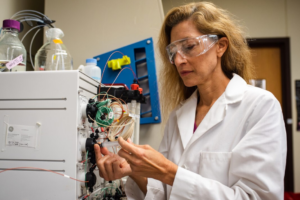Recent surveys of Americans indicate “threats to democracy” as a top concern, only slightly ahead of usual economic choices of “cost of living” and “jobs and the economy.” These concerns are interrelated between energy and environmental constraints. Yet most political discourse ignores these connections to the detriment of public understanding. This lack of understanding then leads to unnecessary political polarization as Americans become disillusioned with both private company and government decisions.
What we need is a sufficiently large population and set of decisions makers that have sufficient insight into the nature of the complex social, economic and political systems within which we live.
The “pain at the pump” news headlines often appear when gasoline prices spike, as they did this year. These headlines are too simple. A deeper explanation places our contemporary situation within the context of centuries-long decreases in energy cost alongside increasing consumption levels.
The most common economic framework assumes that our small level of energy spending (usually 4%-6% of all spending) means that reductions in energy consumption have an equivalently small influence on the economy. But energy consumption enables physical operation of the economy as food for humans and fuel for machines. So, no energy consumption, no economic activity.
Consider three phases of U.S. growth since World War II: Phase 1 (1945-1973), Phase 2 (1973-2000) and Phase 3 (2000-today). Each phase has a distinct rate of growth in energy consumption: 3% (fast, Phase 1), 1% (medium, Phase 2), and 0% (stagnation, Phase 3). The shifts to new phases correspond to important changes in socioeconomic indicators.
First, the percentage of total spending on food and energy, a measure of cost, decreased from the start of the industrial revolution until the year 2000, a level from which it has not declined. In 2022, Americans are allocating 11%-12% of spending to food and energy, the same as in 1994. In other words, since energy costs had declined for a century, we’ve neglected to pay attention to the fact that they have not for the past 20 years.
Former President Richard Nixon ended the gold standard for the U.S. dollar in 1971. Along with more expensive energy, this triggered an increase in the ratio of U.S. private and public debt to GDP from 1.5 in the 1970s to its peak of 3.8 in 2009 (Phase 3) after which it has remained above 3.4. The higher the debt ratio, the lower interest rates must be to avoid a financial collapse.
Phase 1 coincided with the least polarized U.S. Congress since the Civil War. Congressional polarization has increased ever since. Although we should expect increased political intransigence as economic growth slowed, we are victims of circumstance. We should use this knowledge to realize new forms of cooperation.
Finally, U.S. worker compensation as a share of GDP increased, remained constant, and decreased during Phases 1, 2 and 3, respectively. Slower wage gains since the 1970s are not independent of inflationary pressures underpinned by energy costs, primarily due to peak U.S. oil production (at the time) and increasingly globalized trade triggered by resource constraints. The world is again experiencing energy constraints unseen since the 1970s.
Policymakers should put these and other trends in the context of what we can control. We more directly control the distribution of economic output, via tax policy, than we do the quantity of energy consumption and subsequent economic output.
Despite tremendous energy-related technological change during the past decades, neither “drill baby drill” for oil and gas nor a renewable energy transition ensures a return to 1950s-level rapid growth that will bail us out from choosing to stabilize our democracy.
Americans correctly perceive threat to our democracy. Unfortunately, too few realize this threat is rooted in fewer viable economic and political options as limited by energy supplies and costs. By moving energy discourse beyond short-term “pain at the pump” to longer-term trends, we use knowledge to quell a threat based on ignorance.
Carey W. King is a research scientist in the Energy Institute at The University of Texas at Austin.
A version of this op-ed appeared in The Hill.




